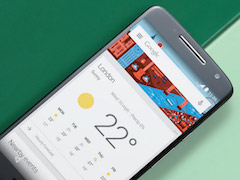

And with the Moto X's reliance on Android soft keys for navigation, that particular boast is unsurprising.

But Motorola's Rick Osterloh, SVP of Product Management, did tell us that 70 percent of the device's front face is all screen. Remember the "edge-to-edge" claims Motorola made with the Droid RAZR M? The Moto X is launching with nary a mention of that jargon. Moving on, smack dab atop the Moto X's sloping top edge, you'll find the 3.5mm headphone jack, while the nano-SIM tray, which requires a pack-in key (or paper clip) to open, occupies the left edge and, finally, the micro-USB port lies at the base. Which doesn't appear to be the case here. I don't know about you, but when I plunk down $199 and sign away two years of my life to a carrier, I want to know that the two buttons used most on a phone will be sturdy and everlasting. They actually make a slight noise when you jiggle them in their sockets. The volume rocker and power button, both slivers of painted plastic on the device's right edge, are loosely secured and flimsy. Like the bellies of swans, the white Moto X's backplate can get ugly pretty quickly. Keep that in mind when you're making your purchase. No amount of soap, water or Clorox wipes were able to completely eradicate these dark black scars. I know because within one hour of owning the device, an innocuous rubber stand we'd used as a photo prop managed to scuff the backplate. That precious woven white backplate, however, will get messy. But much like those toys made for toddlers, the Moto X also looks like it's prepped to endure hard knocks and drops. I use the HTC Droid DNA on a daily basis - a phone that also retailed for the same $199 contracted price - and despite the obvious design similarities (curved back, blunt edges), the Moto X ends up looking like a Fisher-Price toy in comparison. The glossy white plastic that frames the device looks chintzy. Quality craftsmanship isn't the first association that springs to mind when looking at the Moto X. Remarkably, it's even somewhat demure, as Verizon's silvery logo, and that of the AT&T models we've seen, have a way of fading into the background. From what I've seen of carrier-locked models, branding for each operator will appear towards the backplate's bottom end and nowhere else. Motorola's "M" logo lies just beneath in a circular depression that's acutely placed here is where your pointer finger will naturally rest when holding the phone. Centered on the uppermost part of this backplate is the 10-megapixel ClearPixel rear camera with an LED flash below and speaker grille to its right. The backs of the woven white and black models have a trippy, Magic Eye-like effect, with a 10.4mm thickness that tapers to 5.6mm at the edges. Motorola never specified just what materials make up the 130 grams that is the Moto X's composite shell, but you can safely eliminate Kevlar and metal ( Droid staples) from that list. As soon as Motorola's wood-backed prototypes pass testing and hit the market in Q4, I'm confident the Moto X'll become the "it" phone to have, the new black. And just wait until you can get a wooden Moto X. Having seen the litany of custom hues possible at the product's unveiling, I can assure you, the Moto X's beauty is truly in the eye of the prospective owner - a luxury sadly reserved for AT&T at launch. It's unspectacular, but that superficial fail can be easily overturned by a visit to Moto Maker. The woven white unit, a Verizon variant, is too plain-Jane for my tastes. In the sea of tech products that litter my home, the Moto X is the least conspicuous - my eyes are never drawn to it. I've had the Moto X for five days now and the bond I've formed with it has nothing to do with its body. Here's how I see it: You know those people who own iPhones, but don't know which model number they own and also refer to all Android phones as Droids? This phone is for them. The Moto X exudes no tech halo like the Galaxy S 4 or the HTC One because it is the sum of averages. The 4.7-inch screen size, the curvature of its back, the composite materials, its weight and front-face look were focus-tested for maximum inoffensiveness. It's the product of a democratic process - you can take that future design poll on Facebook as proof of this point. If I'm right in reading between the lines of Google's marketing speak, the Moto X was made in the image of the everyman. This is America's smartphone and it costs $199 on a two-year contract. It also comes with a homespun narrative: it's assembled here in the USA. The Moto X, its newborn monarch, arrives in an array of different colors, made possible by the NikeID-like Moto Maker site. The subsequent passage of time allowed it to transmogrify and re-emerge a thing of red, yellow, blue and sometimes green beauty a Google thing made by a Google company. One year ago, Motorola, fat and fed by its Google acquisition, inched quietly into a silicon-spun cocoon to gestate.


 0 kommentar(er)
0 kommentar(er)
